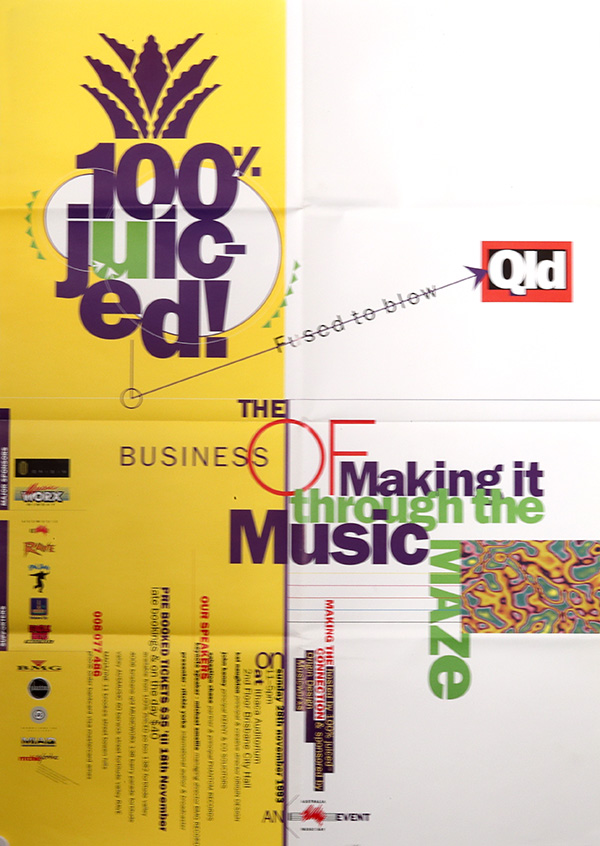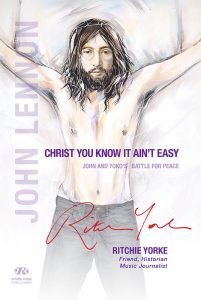
12 Nov 100% Juiced Address 2nd November 1993
SEBASTIAN CHASE ADDRESS
When I was first invited to speak to this seminar on the subject of A & R, I thought, “No problem, there’s a lot that I can say on that subject.” As the time drew nearer, I thought I’d better prepare a paper on the subject. And so, I began. A & R is an abbreviation for the term Artists and Repertoire. It is used to define that component of a record company’s structure that involves an A & R Department, a Director, a Manager or a Person. A & R functions to deal with aspects of the company’s activities related to evaluation of talent, signing artists and producing the company’s artistic output. Seems like simple straightforward stuff. Well not so. I had just started out and I was already stumped. I’d turned into a roundabout that had arterials shooting off in every direction. The function is easy to explain but the form is endless with variation. Very quickly I arrived at the entrance of a maze – where do I go, what will I say? Well, consider that the A & R function in its origin had two separate and distinct strains. Firstly, the dominant strain was concerned with the matching of songs or repertoire with the singers on a label’s roster. For example, Paul Anka’s My Way, sung by and made popular by Frank Sinatra, and later of course de-popularized by Johnny Rotten.
This type of A & R was mainly practised by major record companies and labels which had A & R departments dealing with that specific agenda. These A & R departments were concerned with the discovering and launching of a star, and then finding the right material to have hits and thus maintain the star’s status and record sales. Probably the most notable and indeed quotable of this type of A & R man was Columbia’s Mitch Miller, the bearded bandleader who went on to become the head of A & R for one of the biggest record companies in the business. He spent his days looking for new songs for a formidable label of stars that included Doris Day and others of her ilk. The second A & R strain was practised mainly by small independent labels such as Chess Records, the label that recorded Chuck Berry and a host of others. Their prime A & R focus was concerned with original artists performing their own original songs. The most notable example of this kind of A & R approach was John Hammond, who replaced Mitch Miller at CBS and signed many original artists including Bob Dylan. At the time, Dylan was often referred to as “John’s Folly”. John also signed American’s working-class hero, Bruce Springsteen. Following the breakthrough success of the Beatles and of Bob Dylan, this second stem of A & R became the dominant force – original artists performing original material. The commonality shared by both these strains is that they were driven by record companies and directed an activity that was exclusive to those operations.
As we head into the year 2000, there’s ample evidence that both strains can co-exist. Contemporary original artists such as Lenny Kravitz are either making obvious references to past performers writers and music styles – in this instance, Jimi Hendrix – or they are covering previous hits, such as the Lemonheads’ version of Simon and Garfunkel’s Mrs Robinson. So, to recap, the traditional form of A & R function in the 40s, 50s and on to the mid-60s was primarily concerned with matching the singer and the song. It then became essentially concerned with original artists recording their own songs. And from the mid-80s, the two forms of A & R have to some extent become integrated with the strong emphasis on original artist output. I’m assuming that most of the people attending this forum are concerned with original artists and original output. I have therefore focused on A & R as it pertains to this particular approach. In my opinion, A & R in the modern context is not longer – and has not been for a long time – an activity exclusively conducted by record companies and entrepreneurs. In the contemporary music industry, A & R has become a process where artists are no longer launched as much as they are developed. By definition, the A & R process begins with the artist. The artist – by his or her own artistic and creative output – initiates the A & R concept.
In this context, the function of the A & R department of a record company is to recognize artist merit and decide on its suitability to their business enterprise as they see it in that particular point in time. The emergence of the global marketplace, coupled with the continuing advancement of technology in the areas of recording, communication and transportation, has brought about a trend towards A & R becoming more de-centralized. REM developed a career worldwide form their provincial base of Athen, Georgia, which is relevant to your community because here you are in Brisbane and you’ve got to address you’re A & R process so that you can beam from Brisbane into Sydney and Melbourne and nationally. REM is American of course and did their thing out of America but it remains a very relevant role model to look at. The Allman Brothers Band did the same thing out of Macon, Georgia, a few years earlier. Nirvana and Mudhoney are from Seattle and Crowded House did not need to expatriate to gain worldwide market acceptance. DEF FX are only three years old but already they’ve toured America three times. They have an American record deal, but they live and record in Sydney. It’s apparent that all of the bands I’ve mentioned knew how to get signed. They had established strong provincial markets that grew slowly and cost-effectively. I think it’s really important for people to focus in on what it costs to gain success. If you’re too expensive, you’re probably going to deny giving somebody the opportunity to sign you. So, you have to look at costs as being relevant to the A & R development program. These groups grew from regional to state to national and international markets. They developed a culture and a commercial track record to attract the big boys of the A & R world. They found or created advantages to assist negotiation of the most important document of their entire career – the major international record deal. They met the A & R process head on and half way. The good news about de-centralized A & R is that it is heading your way.
It is up to you to make sure that you are noticed. The best way to do that is to start heading towards them. Meet them half way. Don’t wait for them to come knocking on your door. You can do this by releasing records – even record that you initially consider to be demo tapes. If you send a demo to a record company, it should be produced in such a way that it can be converted into a record. If you can get something released, then you start the process of developing your market. You’ll instigate radio airplay – even if it’s on a narrowcast station format – you’ll also instigate print reviews, critical acclaim. These are all things that you’ll eventually use to convince someone else that they should invest money in you and your career. But there is a point where excessive demo-ing becomes absolutely useless, in my opinion. It might take some investment on your part. If you’re asking somebody else to invest in your career, at some point you’ll have to consider the scenario of – Are you worth investing in yourself? What I’d like to do at some point in these proceedings, is to take you on a slight journey – which consists of basically of eleven steps, starting from the first time you learn to play through to when you’re looking like nailing down a major record deal. This evolution can be portrayed as a railway journey with various stop stations and junctions to the main line.
So, with apologies to Thomas the Tank Engine and to Tommy Emanuel, I’d like to get on board as we ride the Gold Train. It’s the only way you’re ever going to get from point N for Nowhere, to Point S for Success and the various stopover in between. A lot of you here will already have gone through Station One, which is where you learn to play an instrument, including the human voice. You’ll never get anywhere without passing through Station One. It’s a perquisite to every aspiration. Station Two is the crucial early process of practicing, rehearsing, skilling yourself in you craft and getting it to a proficient level. Station Three is a key station where you are beginning to inter-act with your musical peers and with the music industry at large. You’re starting to network, beginning to gain some concept of how the industry works. You’re getting educated. It’s why you’re here now. Station Four is where you branch line meets the main line and you begin station one of your serious commitment period. You’re finding ways of gaining support relationships with agents, managers, club bookers, etc. Self-managing comes into focus as does the overall self-A & R process whereby the act must firm up what it wants to sell. If you don’t know what you’re selling, it’s unlikely that anybody else in the industry will want to buy it.
You must develop a sampling of your image and your musical direction. Connecting with manager at this point in your career is a most important thing because you require the assistance of someone to be part of guiding you through to all the further station stops. Station Five is the career-joining junction where you must come to terms with your recording directions. Undertaking the production of a demo or self-made EP for selling at gigs or using to create other opportunities. This will be used to not only sell to the public but to influence the infrastructure of the established music industry. Station Six is identification time. Identifying not only what you’re trying to sell but WHERE you’re trying to sell and HOW. Develop an approach pattern and style of presentation that will impress and assist rather that detract from what you’re trying to project musically.
Station Seven brings you into presentation mode when you attempt to evolve from provincial to national level. Station Eight has the potential to make you feel great – if you latch on to a national distribution deal with either a major or an independent record label. Station Nine is where you explore the obvious benefits of having achieved national visibility of your product and the resulting coast-to-coast visibility. You tour, do media interviews, TV shows, anything to put public focus on your act. Station Ten provides the territory and opportunity to consolidate your support systems and develop strategies to fine tune your targeting. If it’s worth doing, it’s worth doing for the world. No more short cuts. Planning your connection into the global market by seeking an international distribution deal with a major label. Station 11 is not quite heaven but you’re on the right route. Time to reflect and re-aim. Everything up until now has been a rehearsal for the main chance, for an emerging artist whose ambition is to connect into a global market, you need to attract the right kind of record deal.
With the right kind of capital behind that record deal. It will more than likely be provided by a major label because indies don’t have sufficient money for that sort of deal. So, everything that you’ve done in the previous eleven steps has really been an A & R process to connect with the A & R process of a major record company to give you the funds to continue your career in a global sense. So, A & R isn’t just choosing the song or making the product. It has tremendous financial implications. For instance, the A & R area is where artists will spend most of their money in any record deal. That’s where they end up in debt to the label in terms of video costs, record production, some of the tour support that goes into promoting the sale of those records. So, you can’t detach A & R from the entire process of you career. It’s fundamental – the heart of everything that you do. If you’re going to make it, you’ll make it because you got you’re A & R process absolutely right. Imbued in the A & R process is the need for a career strategy. You must know which steps to take first. A lot of bands rush in and do a major record deal as soon as they get the opportunity. Quite often it’s too much for the Oz market and way too cheap for the international market. It just doesn’t have the funds and the built-in mechanisms that will carry the ambition. The ambition may be there, it sits in abstract to the actual agreement.
So, the agreement cannot function if it doesn’t have sufficient capital reserves built into it. That’s the theory. From a practical point of view, if you’re sitting in Brisbane, I think that the obvious thing is that you make a demo and send it to the major labels. There’s only seven of them. If they don’t sign you, you have to consider the question of what happens now. Do you give up or do you keep going? If you keep going, how do you keep going? Majors are constantly being presented with bands at various stages of development with various political connections at management level. Glenn Wheatley might have a second artist to pitch – he’s obviously going to be able to reach the majors a whole lot quicker than someone representing a band out of Brisbane. Unless that particular act had something incredibly dynamic or extraordinary happening. Trouble is, you have to be almost developed for them to recognize that.
So, you’re in the position of having sent in your demos and you don’t get a response. The route that music history has shown works very well (not only here in Oz but right back to the 50s in America), is to take the independent route. Beg, steal or borrow – release your own record. Form an association with an indie label which understands what you’re trying to do, one that can complement and is willing to invest some time or money or a combination of both – and you get things moving. If you look at the example of REM, they didn’t sign with Warners until probably their fifth album, but when they did do the deal (not that I’m privy to the details of it), one would imagine that the deal is structured to suit REM having a long-term career in the music business


